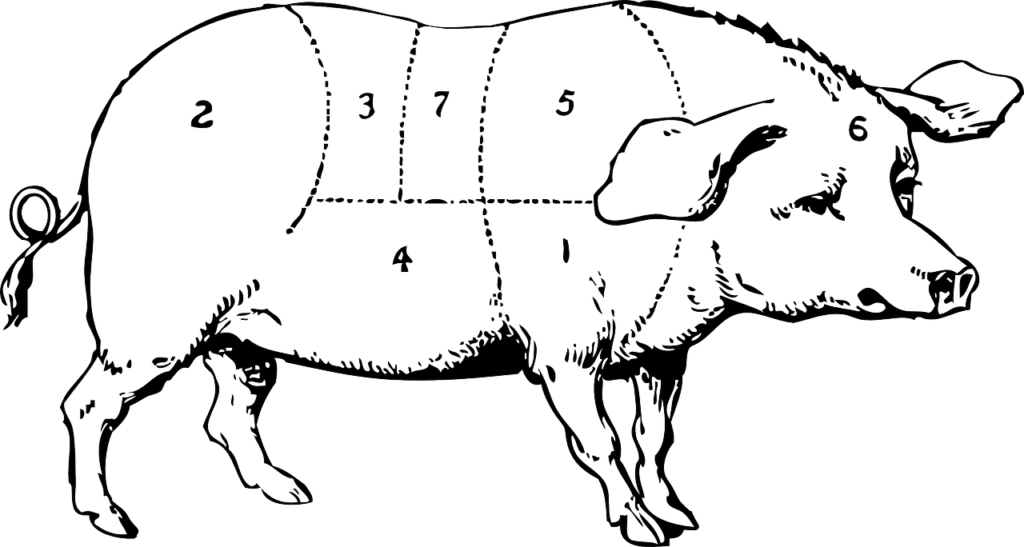By Abbie Sommer
When I’m reading a menu at a restaurant and the word “bacon” comes up (or even better “bacon lardons”), I am almost always going to order the dish. In my opinion, bacon makes everything better. But bacon has a little bit of a bad rep, in part, from its ingredient, sodium nitrite. The fear of nitrates and nitrites has led food companies to produce bacon without them. But what are nitrates? And, are they harmful? This confusion led me to focus on bacon in this edition of “What’s in my food?”.
What is bacon and how is it made?
Bacon came about hundreds of years ago as a way to preserve pork. In the United States, bacon is generally made from the cured belly of a pig. Curing is a term used to describe a number of methods of food preservation that use salts to draw out moisture and make food last longer. After curing, the meat is smoked and, optionally, sliced (see the figure below).
 Graphic by Abbie Sommer
Graphic by Abbie Sommer
What are the ingredients in bacon and why are they there?
The Meats

Image by Clker-Free-Vector-Images from Pixabay
The meat that is traditionally used in bacon is pork belly (think number 4 on the image above). If something other than a pork belly is used, it must be specified1. For example, bacon from a pork shoulder (number 5) must be called “pork shoulder bacon.”
Sugar and Salt
Sugar and salt are of course used for flavor, but also act as antimicrobials. A lot of salt is used in bacon, so the sugar can help to balance the flavor out2.
Nitrites, nitrates, and nitrosamines
Sodium nitrite, not nitrate, is generally the nitrogenous ingredient added to bacon. Nitrate can also be added, but is quickly reduced to nitrite in the meat2. Nitrites are converted to nitric oxide in the meat and react with different things to create desired compounds. Nitrite-derived compounds act to stabilize the pink color of the meat and inhibit the growth of pathogenic and spoilage organisms, including Clostridium botulinum 2. Nitrites also greatly delay the development of the very potent botulinum toxin1.
As far as the pigments go, nitric oxide can react with the myoglobin (red color) in meat to create a darker red color called nitrosomyoglobin. When nitrosomyoglobin is exposed to heat, we get that great pink color that is typical in bacon (nitrosohemochrome).
So, why are people so concerned about nitrates? Nitric oxide can also react with amine compounds, naturally present in meat, to create nitrosamines. Nitrosamines are known to cause cancer in animals2. This is a scary thought, but the USDA has put plenty of regulations on the amount of nitrates that can be added to meat for this reason. Therefore, they are present in very small amounts.

Raw and cooked bacon. Graphic by Abbie Sommer
Sodium erythorbate and sodium ascorbate
There are also additional ingredients like Vitamin C and Vitamin E that are required to be added to bacon to make sure these nitrosamines are not formed in the first place1. They do this by making sure there is not too much free nitric oxide by accelerating the reaction of nitrite with the meat1. In most commercial bacon, sodium erythorbate or sodium ascorbate are added for this reason.
Sodium Phosphate
The last ingredient that is ubiquitous in bacon is sodium phosphate, which is added to help the meat retain moisture and prevent the development of off-flavors in the fat3.
And that is pretty much it. Other spices and flavorings can be added to bacon as well, but these ingredients are the main ones. One of the reasons that bacon is so scary to consumers is the number of additives added. However, there are important reasons for adding each of these ingredients.
So, is bacon safe to eat? As far as nitrates are concerned, the USDA has taken steps to make sure it is. But nutritionally? According to the USDA nutrient database, now known as “FoodData Central“, one cooked slice of bacon has about 2.2 to 2.8 grams of fat (3-4% of the daily value). But, that’s just one slice. The calories and fat can add up when you eat the whole pound. I’d say keep eating bacon, but maybe in moderation.
For more information, the USDA has a great webpage devoted to bacon and food safety.
For our last ‘What’s in my food?’ edition on Twinkies, click here!
References
(1) The United States Department of Agriculture. Bacon and Food Safety https://www.fsis.usda.gov/wps/portal/fsis/topics/food-safety-education/get-answers/food-safety-fact-sheets/meat-preparation/bacon-and-food-safety/ct_index (accessed Apr 2, 2020).
(2) Hui, Y. H. Meat Industries: Characteristics and Manufacturing Process. In Handbook of Meat and Meat Processing; Hui, Y. H., Aalhus, J. L., Cocolin, L., Guerrero-Legarreta, I., Nollet, L. M., Purchas, R. W., Schilling, M. W., Stanfield, P., Xiong, Y. L., Eds.; CRC Press: Boca Raton, 2012; p 957.
(3) Gonzalez, J. Non-Meat Ingredients – Sodium Nitrate, Salt, Phosphate, Etc. What are they and what purpose do they serve? https://meatscience.org/TheMeatWeEat/topics/processed-meats/article/2015/07/24/non-meat-ingredients-sodium-nitrate-salt-phosphate-etc.-what-are-they-and-what-purpose-do-they-serve (accessed Apr 2, 2020).

Abbie Sommer | Linkedin | Website
After graduating with a B.S. in Food Science from Purdue University, Abbie decided to move one state over to pursue a Masters from Ohio State. Her research is focused on soy-based functional foods for use in clinical trials. When she’s not making thousands of soft pretzels (for science, of course), you can find her training for half marathons or experimenting in the kitchen. Recently, Abbie has developed a passion for sourdough and treats her starter like a child. She also has a recipe blog (Sommer Eats) as well as an Instagram account (sommer_eats), where she posts somewhat healthy but always delicious recipes.






Leave a Reply